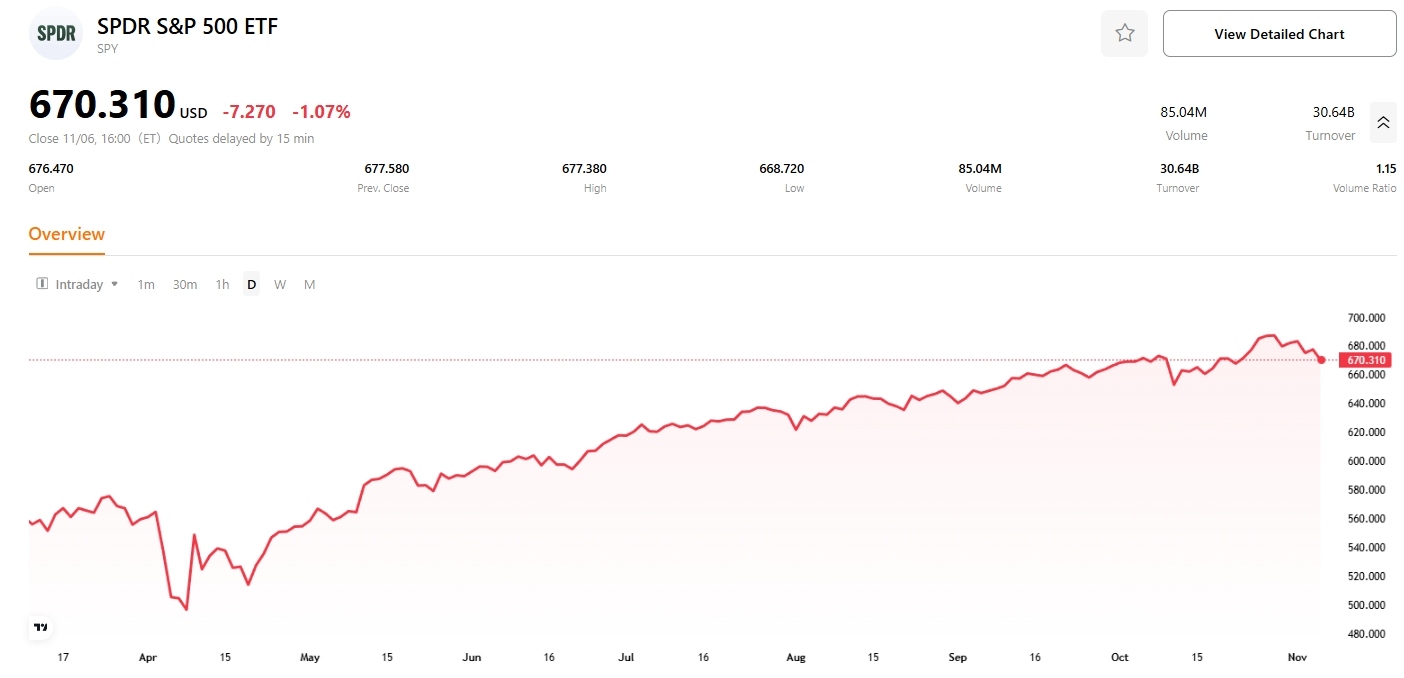US Stock November Prediction: Investors Weigh Seasonal Rally Against Concerns Over AI Valuations

TradingKey - After the S&P 500 Index posted its longest monthly winning streak since August 2021 with six consecutive gains, a hawkish Federal Reserve and concerns over artificial intelligence (AI) valuations have clouded the start of November for U.S. equities. Amidst a broad tech sector pullback, market sentiment remains underpinned by the "tried-and-true pattern" of a seasonal November rebound or year-end holiday rally, coupled with investors' readiness to buy on dips.
As of the last trading day of October 2025, both the S&P 500 and Dow Jones Industrial Average had advanced for six consecutive months. The Nasdaq Composite, meanwhile, recorded seven straight months of gains, marking its longest winning streak since early 2018.
Against a backdrop of political and economic uncertainties, the S&P 500's over 30% surge in the past six months has inevitably led investors to take profits.
Federal Reserve Chair Jerome Powell unexpectedly dampened expectations for a December rate cut at last month's FOMC meeting. Furthermore, recent warnings from prominent Wall Street executives about elevated AI valuations, alongside the U.S. government's hints of caution regarding AI companies like OpenAI, have contributed to the S&P 500's approximately 2% decline so far in November.

【SPDR S&P 500 ETF, Source: TradingKey】
JPMorgan Chase CEO Ted Pick believes the U.S. stock market could experience a 10% to 15% correction, which he considers a normal characteristic of a long-term bull market. Goldman Sachs CEO David Solomon stated that tech stock valuations are already full, projecting a 10% to 20% correction for U.S. equities over the next 12 to 24 months.
Murphy & Sylvest analyst Paul Nolte noted that while valuations remain a significant concern in the long run, the market still holds a bullish outlook. Nolte pointed out that the stock market's rebound after a 1% to 1.5% drop this week indicates that the "buy-the-dip mentality persists."
With investors reluctant to exit, the historical pattern of a year-end seasonal rally in U.S. stocks may also provide a psychological safety net for participants.
November's Golden Run for U.S. Equities
Bank of America found that November has historically been a strong month for stock market performance. The bank's analysts suggest increasing exposure to the Halloween or Christmas rally, as historical data shows this often funds New Year celebrations.
Data indicates that since 1927, the S&P 500 Index has risen in November 59% of the time, with an average monthly gain of 1%.
LPL Financial also highlighted that since 1950, November has been the strongest performing month for the stock market, with November and December being the two months with the highest average returns.
Analysts attribute this seasonal uptick to holiday cheer boosting stock purchases (or the start of the Santa Claus rally), a reversal in mutual fund allocations after tax-loss harvesting at the end of October (fiscal year-end on October 31), and improving macroeconomic signals.
Savita Subramanian of Bank of America emphasized the role of institutional investor reallocation in driving year-end market gains: Since 1986, individual stocks that declined by more than 10% cumulatively between January 1 and October 31 have, on average, outperformed the S&P 500 by 1.9 percentage points over the subsequent three months, with a 70% probability of rising.
In addition to macroeconomic support and strong seasonal patterns, analysts also observe trends within the new presidential cycle. When the S&P 500 posts a strong gain in October of the first year of a new presidential cycle, there is a 92% probability of continued gains in November.
Bank of America anticipates this historical pattern could repeat this year, given moderating inflation and resilient consumer spending.
Investors Reluctant to Depart
An equities specialist at HSBC noted that the shifting market is gradually prompting more people to consider taking some money off the table. This change in market sentiment creates a self-reinforcing dynamic, which the equity market is currently experiencing.
Nevertheless, a stronger-than-expected U.S. Q3 earnings season, an improving outlook for Fed rate cuts due to weakening employment data, and the continued expansion of capital expenditures by tech giants remain powerful pillars for investors.
Matt Rowe, a portfolio manager at Man Group, commented that despite high valuations, people still don't want to miss the opportunity to see how capital expenditures translate into earnings. The market right now feels like a tug-of-war.
Ed Yardeni, founder of Yardeni Research and a long-term U.S. equities bull, noted this week that the S&P 500 trading 13% above its 200-day moving average suggests the rally since April has been overextended.
However, he anticipates a low probability of a significant correction exceeding 10%, therefore advising investors to buy on dips rather than selling in anticipation of a sharp pullback.
This content was translated using AI and reviewed for clarity. It is for informational purposes only.








